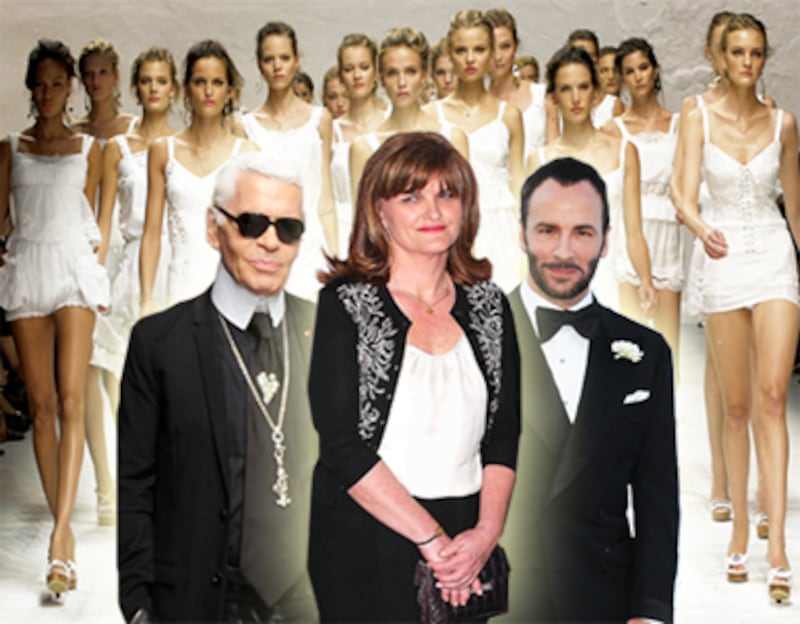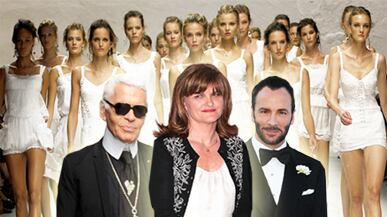At Tory Burch, there was so much foot traffic shoppers spilled into the streets. At the Billionaire Boys Club, a clothing store by record producer Pharrell Williams, lines snaked around the block.
In the days that followed, reports poured in about what a success the second installment of Fashion's Night Out had been in New York—helping a fashion economy reeling from a slowdown in consumer spending.

But one person dismayed by it all was The New York Times' Cathy Horyn.
"I hope it doesn't go on," she says, a week later, seated at a café on the Upper West Side in between the fall fashion shows. "I don't want it to continue… You know, we're a nation of shoppers. That's how people spend their time, shopping online, shopping in stores, acquiring. And I feel like we perpetuate that with Fashion's Night Out. What are you really celebrating? Not art or great books. You're celebrating shopping."
Of course, it's not irrational to take issue with an event that's basically a fundraiser for global capitalism. But the position is somewhat unusual for a person in Horyn's line of work.
For the last 12 years, she has been the Times' fashion critic, covering a multibillion-dollar industry that depends almost entirely on a culture of shopping. Moreover, most "fashion journalists" work for magazines that exist to help sell clothes, so Horyn's attitude ruffles more feathers than it would in an industry better accustomed to aggressive journalism.
At various points, Carolina Herrera, Giorgio Armani, Dolce & Gabbana, Helmut Lang, Nicole Miller, and Oscar de la Renta have all banned Horyn from their shows. When she won the CFDA award for fashion journalism back in 2002, Women's Wear Daily celebrated the event with an article, "Does The New York Times Hate Fashion?" complete with a quote from Oscar de la Renta who argued just that: "Cathy Horyn is not one who loves fashion or enhances fashion in any manner," he told WWD. "There are personal commentaries and digs, not only about the designers, but about people who attend the shows, which I consider unnecessary and unprofessional in reviewing a collection… I'll say it. I'm not a coward."
None of this has seemed to faze the journalist, who, this fashion season, displayed her trademark ability to excite and infuriate.
Her profile of The Jersey Shore's Nicole "Snooki" Polizzi recently drew more than 800,000 page views on the Times website as well as sharp rebukes from press critics like Salon's Mary Elizabeth Williams, who said the article "neatly encapsulates everything most despicable about the Times and its cultural coverage—its snotty, keep 'em at arm's length, can you believe these people? attitude, the way you can practically feel the reporter holding her nose while she writes."
"I wanted to say to people 'read the article,'" Horyn says. "I described her as a silhouette and an icon by virtue of her pouf and her body shape. I've acknowledged her and her impact. But am I going to be tough with her? Yeah. I don't think people understood it, honestly, and I don't know what they expected to read."
Then, as Fashion Week got under way, Horyn reviewed wunderkind Alexander Wang's spring 2010 collection and said he is "not a great designer," but is successful because his clothes are made in China and are priced to sell. Later, in Europe, there was a stinging review of Balmain, a house that has achieved near-mythic status among the fashion crowd. "Yikes," she wrote. "Mr. Decarnin isn't one for change, but couldn't he have hit a fashion button other than redial?"
And then there was her review of Tommy Hilfiger, whose 25th anniversary show coincided with New York Fashion Week. Horyn deconstructed the invitation—a plastic swatch of privet in a transparent plastic box—describing it as a "perfect" metaphor for how the milestone felt like a marketing push. And that was just the beginning. She tore into the celebrities seated in the front row (Jennifer Lopez and Bradley Cooper) as well as the clothes. "For Mr. Hilfiger," she wrote, "the runway may be paved in imitation fieldstone."
"It was terrible," says Horyn, who's 54, a brunette, and on this afternoon wears a simple black dress, conveniently forgetting who designed it. She also sports a sparkly new ring given to her by her boyfriend, Art Ortenberg, the widower of Liz Claiborne. "When Ralph Lauren did his big anniversary party in Central Park, it was one of the most elegant evenings I can remember. So if Tommy's doing his anniversary, he has the ability to say, 'Do I really want to have all these cheesy celebrities?'—and celebrities that as far as I can see have no relationship to his brand. It's not friendly. It's not intimate. It's there to get some pictures and then the clothes come out… I found it very artificial."
Horyn may be a big admirer of Lauren's, but it's worth noting that he hasn't escaped her barbs. In 2003, Horyn shocked many in the fashion world with a description of Lauren as a "little man astride a horse swinging a polo mallet."
It was neither the first nor the last time Horyn jabbed at someone's looks in print. This year, she drew fire when she wrote about Mad Men's Christina Hendricks' appearance at the Golden Globes, including an anonymous quip from a "stylist" who said of Hendricks: "You don't put a big girl in a big dress."
"It hurt my feelings," Hendricks recently told Harper's Bazaar. "I thought that dress was stunning. I stand by that dress to this day. I had just gotten back from my honeymoon, and I felt beautiful."
In retrospect, Horyn thinks she made a mistake—though she says she didn't mean to be derisive about the actress' weight. "She's a lovely girl," Horyn says. "I should have stepped back and explained what that person meant. It wasn't about Christina's figure. It's about what looks best."
Horyn is less apologetic about Wang, saying she wants to bring a critical eye to those admired uncritically. "I don't think that's any different than Christopher Hitchens talking about Mother Teresa," she says. "With Alexander, he's a smart kid, I admire the business that he's built, but you have to be critical of what he's done. You can't just say 'oh well, he's young and he's working hard, he's putting a product on the runway.' I found that show boring. I may not have found other shows boring, but I found that one boring."
And a boring show doesn't go over well with a woman who's spent more time in fashion than many career models or designers. Horyn grew up in Ohio. Her mother worked for a foundation; her father was a journalist who worked for The Columbus Citizen-Journal, covering, among other things, executions. After graduating high school, Horyn went to Barnard College, got a master's in journalism from Northwestern, and went to work at the Virginian-Pilot, where, for the next six years, she covered everything from school boards to home furnishings.
In her mid-twenties, single and pregnant with her only son, she moved to the Detroit News and her first job as a fashion reporter. After that, The Washington Post Style Section came calling, then Vanity Fair, where she covered celebrities and fashion designers. When the Times' late fashion critic Amy Spindler was hired as the Times Magazine's style editor in 1998, Horyn replaced her at the paper and quickly earned a reputation for not pulling punches.
“She’s not neutered, let’s put it that way.”—Donna Karan
"Amy and I shared the same Midwestern quality, which is that we want people to be better," Horyn says. (Spindler died of cancer six years ago). "We have standards. We want people to be not just good but very good. And I can be tough on people, sometimes too tough, especially with the most creative. I once called one of Tom Ford's collections freakish and ugly."
Today, few designers ban her from coming to their shows, but they don't seem eager to acknowledge Horyn's importance either. During Fashion Week, I went from show to show, and party to party, asking about Horyn. Almost everyone declined comment or claimed that they don't actually read her reviews.
"I prefer to look at beautiful pictures in magazines like American Vogue and French Vogue by editors like Anna Wintour and Carine Roitfeld," Karl Lagerfeld told me.
"I don't think reviews really matter anymore," said Carolina Herrera.
Donna Karan allowed that getting swiped by Horyn "still hurts."
"You can agree or disagree with her, but it's definitely passionate. She's not neutered, let's put it that way."
Not that her criticisms are always easy to make sense of. One of the favorite pastimes of fashionistas is reading aloud from Cathy Horyn and asking "what does this even mean?" Take a review from the current fashion season: "If irony is the thread that runs through modern fashion, then the Chanel cardigan jacket is the eye of the needle."
"I think her sentences are like a series of poses. It's as if she's walking down the runway as she's writing," said Bob Colacello, who covers society and culture for Vanity Fair. "She's intelligent, but I think she's trying to make something out of fashion that it isn't."
Sarah Jessica Parker was kinder. "I love reading her, and I'm rightly intimidated by her, which I like… She's Pauline Kael."
Another oft-heard criticism is that Horyn doesn't seem to like anything—a charge somewhat countered by her focus on the horse race between Nicolas Ghesquiere at Balenciaga and Raf Simons at Jil Sander to be leader of the fashion pack—a focus that sometimes gets in the way of addressing important style developments taking place off the runway.
In 2009, as the global economy had begun its meltdown, Horyn wrote an article called "What's Wrong With Vogue?" in which she criticized the magazine for running a piece about a rich woman going to Walmart for the first time, calling it "embarrassing" and "out of touch."
Yet during the entire presidential election of 2008, Horyn was completely silent about Sarah Palin and what her style/presentation indicated about the changing image of women in the Republican Party. Similarly, style arbiters like Lady Gaga, Madonna, and Britney Spears—who connect high fashion to mass culture in important ways and influence how millions of women dress (for better and for worse)—receive scant coverage from Horyn. She has barely addressed Project Runway. "I just don't really have anything to say about it," she says, with a shrug.
This season, Horyn loved collections from Jil Sander, Lanvin, Louis Vuitton, Rodarte, and Tom Ford. The former Gucci designer's womens-wear presentation was held for a hundred people at his Madison Avenue store and the scaled-back quality was part of what she most appreciated. "It was an incredible experience," Horyn says. "There were no celebrities in the front row, so he was able to control everything and really make you look at the clothes… He could tell a unique story by putting those clothes on a variety of beautiful women, all ages, not calling attention to the fact that some of them are famous, and some of them are older and have all kinds of body shapes. That's what everybody had their mouths open about. It was so beautiful. What an idea. What fashion. And you don't come away with that often."
Jacob Bernstein is a senior reporter at The Daily Beast. Previously, he was a features writer at WWD and W Magazine. He has also written for New York magazine, Paper, and The Huffington Post.




